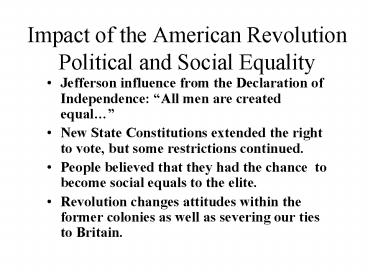Impact of the American Revolution Political and Social Equality - PowerPoint PPT Presentation
1 / 28
Title:
Impact of the American Revolution Political and Social Equality
Description:
New State Constitutions extended the right to vote, but some restrictions continued. ... Veteran Officers hereditary Society of Cincinnati condemned as aristocratic. ... – PowerPoint PPT presentation
Number of Views:138
Avg rating:3.0/5.0
Title: Impact of the American Revolution Political and Social Equality
1
Impact of the American Revolution Political and
Social Equality
- Jefferson influence from the Declaration of
Independence All men are created equal - New State Constitutions extended the right to
vote, but some restrictions continued. - People believed that they had the chance to
become social equals to the elite. - Revolution changes attitudes within the former
colonies as well as severing our ties to Britain.
2
Impact of the American Revolution Political and
Social Equality
- Veteran Officers hereditary Society of Cincinnati
condemned as aristocratic. - Loyalists lands confiscated US veterans given
land bonuses. - Public Education expanded.
3
Impact of the American Revolution on Religion
- All citizens had to support the established
church with taxes in most colonies before the
Revolution. - Thomas Jefferson thought that a partnership like
this between church and state restricted
religious freedom and gave the established church
an unfair advantage.
4
Impact of the American Revolution on Religion
- Virginia Statute of Religious Liberty separated
church and state. - Many other states begin to follow Virginias
lead. - Anglican Church, Church of England, becomes the
Episcopal Church in America.
5
Impact of the American Revolution on
African-Americans
- Blacks-equal more than 50,000 free blacks lived
in America in 1780's - Over 300,000 slaves in the South most Northern
states freed the slaves. - Courts began to favor lawsuits made by slaves
southern states began to give free blacks right
of trial by jury. - Most African-Americans were still slaves.
6
Abigail Adams Remember the Ladies . . .
Link to Biography http//www.whitehouse.gov/WH/gl
impse/firstladies/html/aa2.html
Link to Portrait http//www.firstladies.org/ABIGA
IL_ADAMS/FL.HTML
7
Impact of the American Revolution of Women
- Women-status of women remained unequal.
- Abigail Adams
- denounced the lack of female equality.few
property rights, no voting rights, a few
academies began to admit women.
8
Articles of Confederation Americas First
Constitution, 1781-1789
http//www.earlyamerica.com/earlyamerica/milestone
s/articles/cover.html
9
Articles of Confederation
- Written in 1777 John Dickinson approved 1781
- Alliance of independent states, Weak,
decentralized - Central government was in the form of Unicameral
Congress - Post office Set weights and measures system
- Could declare war/peace and appoint military
officers - Congress could not collect taxes or draft into
the army
10
Land Ordinance of 1785
- Western land divided into 36 square mile
townships - townships divided into 36 sections(640 acres1
square mile). - Townships had to set aside one section for
support of education.
11
Land Ordinance of 1785
- each acre sold for a dollar and sometimes as low
as 10 cents. - Squatters became a problem because the settlers
were afraid that they were going to take over the
land. - Since this was a problem they passed a second
land bill of 1787
12
Land Ordinance of 1785
- The settlers are moving west in search of new
land following the American Revolution. - The confederation government had to come up with
a plan for settlement
13
http//www.exlaw.com/gallery/nword-1.jpg
14
(No Transcript)
15
Northwest Ordinance
- Congress to divide the Northwest Territory into
3 -5 separate states - Once a territory had a population of 60,000 it
could be admitted as a state equal to the
original 13 - Prohibited slavery in Northwest Territory.
- This process used throughout US expansion to the
West even after Confederation ended.
16
Northwest Territory
http//www.ohiokids.org/ohc/history/h_indian/maps/
nwterrit.html
17
(No Transcript)
18
Problems of the Confederation Era
- Revenue Problems
- Economic Depression
- Debts to former allies
- Border Problems with Britain and Spain
- Native Americans
19
US-Spain Border Dispute
33rd Parallel
31st Parallel
20
Daniel Shays and his men
Www.teachingcompany.com
21
Shays Rebellion
- Massachusetts- 1786 and1787
- The rebels also protested taxes and court fees
imposed by the state. - Part of widespread discontent among small
property owners
22
SHAYS REBELLION
- Rebellion by farmers in Massachusetts against
unsettled economic conditions and against
politicians and laws which were grossly unfair to
farmers and working people in general. - They protested against excessive taxes on
property, polling taxes which prevented the poor
from voting, unfair actions by the courts, the
high cost of lawsuits, and the lack of a stable
currency.
23
Shays Rebellion
- Enacted laws to reduce court fees and provide
some relief for debtors - support for strengthening the federal government,
and helped lead the replacement of the Articles
of Confederations, with the Constitution of the
United States.
24
Daniel Shays Rebellion
http//www.sjchs-history.org/Shays.html
25
The Rebellion
- The rebellion started with simple petitions
- They called for paper currency
- Lower taxes
- Judicial Reform
26
Shays Rebellion, 1787
- Shays lead 1100 men in attempt to take over the
arsenal in Springfield, Massachusetts. - Caused by the rough economic conditions faced by
Mass. Farmers who wanted reforms and issuance of
paper money.
27
Rebellion (cont.)
- On August 29, 1786, rebel mobs stormed the
courthouse in Northampton to prevent the trial
and imprisonment of debtors. - In September 1786, Shays and about 600 armed
farmers stormed the courthouse in Springfield.
Governor Bowdoin countered with a militia of 4400
troops.
http//www.shaysnet.com/dshays.html
28
Rebellion (cont.)
- On January 25, 1787, Shays led 2000 rebels to
Springfield, MA to storm the arsenal, but
government forces of 1200 soldiers led by General
Shepard quelled the uprising. The rebels were
captured and sentenced to death for treason in
February 1787, but they were later pardoned
http//www.shaysnet.com/dshays.html































